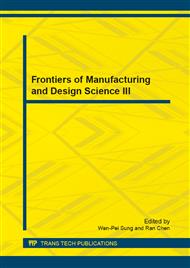p.1397
p.1402
p.1410
p.1415
p.1421
p.1427
p.1434
p.1441
p.1446
Structural Design Optimization of the Rotary Table of a Floor Type Boring Machine for Minimum Weight and Compliance by Using GA
Abstract:
Recently needs of extra-large floor type boring machines have been increased according to super-sizing ships and aircrafts including wind turbines. The rotary table of a supersize floor type boring machine to be developed in this study can support ultra heavyweight workpieces more than 200 tons and be rotated with a speed of 300 deg/min. Therefore, it is designed as a high rigidity structure and requires high rigidity bearings. Thus, hydrostatic bearings are used in this rotary table. For optimizing the rotary table of a floor type boring machine as a lightweight and high rigidity structure, an optimized design is performed using an FEM structural analysis and a genetic algorithm (GA). As a result, it represents a decrease in weight 22.2% and an increases in rigidity 8.56% compared to that of the conventional method based on empirical design.
Info:
Periodical:
Pages:
1421-1426
Citation:
Online since:
December 2012
Authors:
Price:
Сopyright:
© 2013 Trans Tech Publications Ltd. All Rights Reserved
Share:
Citation:


